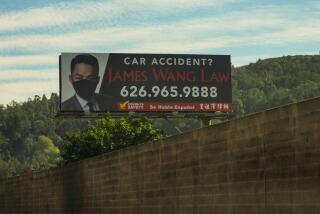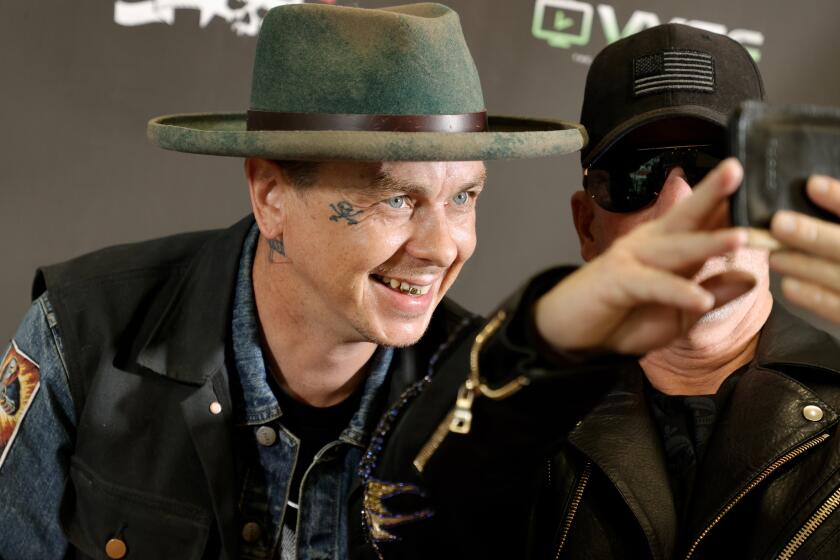It’s Sometimes Hard to Tell Difference Between a Music Video and an Ad
Turn on your TV to a music video channel. Chances are you’ll see a flashy, new video that features pop singer Sheena Easton pumping iron.
Flip the channel and you may see the same workout session--dumbbells and all. But this time it’s a commercial for Holiday Spa Health Clubs.
The quick cuts in the commercial look so much like the exercise scenes from Sheena Easton’s new video, you might think they were lifted right from it. In fact, they were. Not only did the owners of Holiday Spa Health Club pay for the ads, they also bankrolled the video.
It used to be simple. Music companies put out music videos to promote their latest albums. But now, Health & Tennis Corp., which owns 315 health clubs nationwide under such names as Holiday Spa and Vic Tanny, seems to have crossed the already wavering line that separates music videos from advertisements.
The music video “Lover in Me” shows Sheena Easton singing and exercising but never mentions the health clubs by name. But now viewers don’t know whether they’re getting a pitch to buy an album or to join a health club.
“I don’t think the video is a 3 1/2-minute commercial for Holiday Spa,” said Arthur Quinby, vice president and director of marketing for Los Angeles-based Health & Tennis. “Its message is physical fitness.”
Others disagree. “It sounds like rock ‘n’ roll incest to me,” said Robert Guccione Jr., publisher of Spin magazine, the rock music publication. “I suppose there’s nothing immoral about it, but where do you draw the line?”
Sure, some advertisers pay big fees to place their products in music videos and films, he noted, but this is worse. “People have to be honest. . . . What’s wrong is acting like a rock ‘n’ roll rebel, when you’re really an advertising executive.”
Executives at the Los Angeles ad firm that created the commercial, J. Walter Thompson, insist that there is no confusion between the commercial and video.
“It’s only natural that if you discover a part of your product is entertaining, interesting or sexy, you can use it in a music video,” said Burt Manning, chairman of New York-based J. Walter Thompson Co. “But keep in mind, they’re not showing any brand names in the video. Sheena is just doing something very culturally current--working out.”
But while the music video was being filmed, J. Walter Thompson did have a producer on the set. “We wanted to make sure that the footage generated was workable for our commercials,” explained James K. Agnew, executive vice president of the agency’s West Coast operations. “I don’t think anything should be misconstrued, though. It’s just a bunch of cuts that work well with the music.”
As far as MTV Networks is concerned, the video meets its standards. The network has a policy against airing “blatant product endorsements,” said Barry Kluger, vice president at the New York-based cable network. Indeed, the network has been airing the video on cable channel VH-1 since October. “Obviously,” said Kluger, “we don’t think the video appears to be an ad for Health & Tennis.”
And what does Sheena Easton think? Well, she declined to comment through her Los Angeles manager, Harriet Wasserman. And Wasserman wasn’t much interested in talking, either. “I don’t want to make a lot of statements about it.” she said, “But isn’t a video just a commercial for a record?”
His Face May Launch a Thousand Products
About 10 years ago, when Farrah Fawcett had one of the biggest smiles on television, Steve Weston knew that just about anything with her face on it would sell.
So his Los Angeles licensing company, Leisure Concepts, signed a deal that gave him control of the rights to plaster her face on everything from T-shirts to calendars. Since then, however, Weston has learned that celebrities come and go too quickly. So his company has mostly stuck to licensing the likes of cartoon characters such as Dick Tracy, Gumby and even Alf.
Until now, that is.
Morton Downey Jr., the free-spirited--if not free-swinging--syndicated TV talk show host, was added to the list last week. And by week’s end, Leisure Concepts had already signed pacts with licensees who will place Morton Downey’s mug on posters, buttons, key chains and even watches. “He’s America’s newest super-hero,” Weston explained.
But Weston realizes that even super-heroes come and go. So, he said, he hopes that many of the Morton Downey-related products will be on gift shop shelves within three months. Meanwhile, Weston has just begun pitching an idea for one product that he’s certain would be a best seller: a Morton Downey voodoo doll.
Genesis of Warning Was a Cocktail Party
It started out as a promotional gimmick years ago when Bob Kwait worked for a baby-bottle maker in Cleveland. When the company held a party for some sales executives, those attending were served cocktails in baby bottles.
Well, Kwait, who is now the top creative director at the San Diego office of the ad firm Phillips-Ramsey, never got the image out of his head. Something about grown-ups drinking booze from baby bottles “always stuck with me,” Kwait said.
Now, that image has turned up in a public service print advertisement that his agency has just created for United Way. The ad features a photo of baby bottle that looks like it is filled with a martini--complete with green olive. And the ad points out that thousands of babies suffer mental or physical deformities because their pregnant mothers drank alcohol.
Just as striking is the headline under the picture: Pregnant women never drink alone.
Saatchi & Saatchi Gets a High-Tech Challenge
Some of today’s electronic gadgetry is so fancy that it’s often hard to figure out how to advertise the high-tech gizmos.
Take laser discs, for example, the new TV attachments that manufacturers say will offer crystal clear pictures and near-pitch perfect sound for everything from movies to rock concerts.
“There’s a lot of consumer misunderstanding about laser discs,” said Nelson (Skip) Riddle, president of the Torrance-based ad firm, Saatchi & Saatchi DFS. Well, now his agency has a chance to do something to clear up that confusion.
Last week, LaserDisc Corp. of America, the Long Beach-based subsidiary of Pioneer Electronics, handed its advertising business--estimated to be several million dollars--to Saatchi & Saatchi. The agency already handles the $8-million advertising for the firm’s parent, Pioneer Electronics.
What will the advertising say? “Our main focus will be to educate consumers and retailers about what these things are,” said David Wallace, marketing manager at LaserDisc Corp. And how to do that? Well, the company is looking for laser disc fans. Among the endorsements it is trying to line up: big-name movie reviewers.
Demand for Ad Jingles in Spanish Is Growing
Perhaps you’ve heard the pulsating radio jingle for am-pm mini-markets, “I’m the Boss.” In many parts of Southern California, however, the tune may be more familiar as “Soy el Patron.”
The jingle’s two versions were created by HLC, one of the West Coast’s largest commercial music production companies. And because of the growing demand among advertisers for Latino commercial jingles, HLC this month announced the formation of a Latino division that will exclusively write commercial tunes in Spanish.
“We’ve written Hispanic music, off and on, for years,” explained Michael Sheehy, general manager of HLC. “But with the demand exploding, we felt it was time to market directly toward that community.”
As a result, HLC named Jesse Acuna, 39, former lead singer with the rock group Hiroshima, to oversee that division. Acuna has only been in the jingle-writing business for two years. But last week he signed a deal to write jingles in Spanish for a major Latino radio network with stations in Los Angeles, New York and Miami.
Said Acuna: “Los Angeles is such a diverse city of musicians. The best commercial Hispanic music is coming from right here.”
More to Read
The biggest entertainment stories
Get our big stories about Hollywood, film, television, music, arts, culture and more right in your inbox as soon as they publish.
You may occasionally receive promotional content from the Los Angeles Times.










